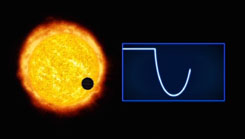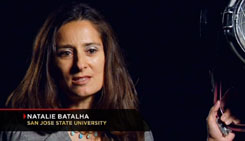This episode explores solar eclipses, lunar eclipses,
planet/moon shadows elsewhere in our solar system, and
the transit technique for detecting extrasolar planets.
The episode introduces the Saros Cycle of the moon's orbit,
repeating a pattern every 223 months. Middle sections
demonstrate the discoveries made surrounding the sun's corona
by satellites using an artificial eclipse-making device called
a coronagraph, and further the season's obsession with
Mass Coronal Ejections and their associated possible disasters
to Earthly civilization.
The final section is the best, however, as we get the earliest report
in "The Universe" of results from the exoplanet-hunting Kepler Mission.
Natalie Batalha:
"We looked at our very first light curves.
We could see transits immediately.
Some of them just popped right out at us!
...Right out of the gate we were reaching the precision levels
very close to what we expected at the beginning."
Exoplanets discussed include:
- Kepler 5b
- Kepler 6b
- Kepler 7b
- Kepler 8b
- Kepler 4b
As of June 2010, Kepler presented 700 new planet candidates,
waiting to be analyzed and confirmed by ground telescopes
and a consensus of scientists.
from the disc sleeve:
Total Eclipse:
Explore the complex movements of Earth, Moon, and Sun that produce
total solar eclipses - one of the most spectacular phenomena in the heavens.
Then, go into deep space, where the tiny eclipses caused by planets circling
distant stars may soon reveal exoplanets, perhaps in habitable zones like
the Earth.
Chapter List:
- Vanishing Sun
- Learning from Eclipses
- Coronagraph
- Solar Maximum
- Light Curves
(Kepler Mission!)
And the "Ask the Universe" question for this episode is...
"What is the current temperature of the universe,
and why is it so cold?"
- Carlo, Boulder, Colorado.
|
Participants include:
|
















